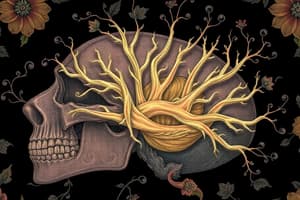Podcast
Questions and Answers
Which cranial nerve is considered part of the Central Nervous System (CNS) rather than the Peripheral Nervous System (PNS)?
Which cranial nerve is considered part of the Central Nervous System (CNS) rather than the Peripheral Nervous System (PNS)?
- Olfactory Nerve (Cranial Nerve I)
- Trigeminal Nerve (Cranial Nerve V)
- Oculomotor Nerve (Cranial Nerve III)
- Optic Nerve (Cranial Nerve II) (correct)
All cranial nerves originate from the brainstem.
All cranial nerves originate from the brainstem.
False (B)
Which cranial nerve is responsible for controlling the lateral rectus muscle, which abducts the eye?
Which cranial nerve is responsible for controlling the lateral rectus muscle, which abducts the eye?
Abducens Nerve (Cranial Nerve VI)
The trigeminal nerve has three divisions: ophthalmic, maxillary, and ______.
The trigeminal nerve has three divisions: ophthalmic, maxillary, and ______.
Match each cranial nerve with its primary sensory function:
Match each cranial nerve with its primary sensory function:
Which cranial nerve provides parasympathetic control over the heart, lungs, and digestive tract?
Which cranial nerve provides parasympathetic control over the heart, lungs, and digestive tract?
The accessory nerve primarily controls muscles of facial expression.
The accessory nerve primarily controls muscles of facial expression.
Which cranial nerve is responsible for tongue movement, and is crucial for speech and swallowing?
Which cranial nerve is responsible for tongue movement, and is crucial for speech and swallowing?
Damage to which cranial nerve would most likely result in difficulty chewing?
Damage to which cranial nerve would most likely result in difficulty chewing?
The glossopharyngeal nerve is responsible for taste sensation in the posterior ______ of the tongue.
The glossopharyngeal nerve is responsible for taste sensation in the posterior ______ of the tongue.
Flashcards
Cranial Nerves
Cranial Nerves
Part of the PNS, these nerves originate from the brainstem (except I & II) and extend to target tissues, transmitting sensory and motor information.
Olfactory Nerve (I)
Olfactory Nerve (I)
Though originating from the cerebrum, this nerve is generally considered part of the PNS.
Optic Nerve (II)
Optic Nerve (II)
Considered part of the CNS, this nerve carries visual signals from the retina to the brain.
Oculomotor Nerve (III)
Oculomotor Nerve (III)
Signup and view all the flashcards
Trochlear Nerve (IV)
Trochlear Nerve (IV)
Signup and view all the flashcards
Trigeminal Nerve (V)
Trigeminal Nerve (V)
Signup and view all the flashcards
Abducens Nerve (VI)
Abducens Nerve (VI)
Signup and view all the flashcards
Facial Nerve (VII)
Facial Nerve (VII)
Signup and view all the flashcards
Vestibulocochlear Nerve (VIII)
Vestibulocochlear Nerve (VIII)
Signup and view all the flashcards
Accessory Nerve (XI)
Accessory Nerve (XI)
Signup and view all the flashcards
Study Notes
- Cranial nerves are part of the Peripheral Nervous System (PNS) with one exception.
- The optic nerve (cranial nerve II) is considered part of the Central Nervous System (CNS).
- The optic nerve is part of the CNS because it is an extension of the brain.
- Most cranial nerves belong to the PNS because they originate from the brainstem (except the olfactory and optic nerves).
- These nerves extend to target tissues in the head, neck, and thorax.
- They transmit sensory information (smell, vision, and touch) and motor commands to muscles.
Exceptions to the PNS Rule
- Optic Nerve (Cranial Nerve II): Derived from brain tissue and covered by meninges; carries visual information and is part of the CNS.
- Olfactory Nerve (Cranial Nerve I) is generally considered part of the PNS despite originating from the cerebrum.
Cranial Nerves and Their Functions
- Olfactory Nerve (Cranial Nerve I):
- Function: Smell (sensory).
- Pathway: Transmits information from the nasal cavity to the brain.
- Optic Nerve (Cranial Nerve II):
- Function: Vision (sensory).
- Pathway: Carries visual signals from the retina to the brain.
- Oculomotor Nerve (Cranial Nerve III):
- Function: Eye movement (motor), pupil constriction, and lens accommodation.
- Controls most eye muscles, eyelid movement, and focusing.
- Trochlear Nerve (Cranial Nerve IV):
- Function: Eye movement (motor).
- Pathway: Controls the superior oblique muscle, allowing the eye to look downward and inward.
- Trigeminal Nerve (Cranial Nerve V):
- Function: Facial sensation (sensory) and chewing (motor).
- Divisions: Ophthalmic, Maxillary, and Mandibular.
- Abducens Nerve (Cranial Nerve VI):
- Function: Eye movement (motor).
- Pathway: Controls the lateral rectus muscle, moving the eye outward.
- Facial Nerve (Cranial Nerve VII):
- Function: Facial expressions (motor), taste (anterior 2/3 of the tongue), saliva and tear production.
- Vestibulocochlear Nerve (Cranial Nerve VIII):
- Function: Hearing and balance (sensory).
- Pathway: Transmits sound and equilibrium information from the ear to the brain.
- Glossopharyngeal Nerve (Cranial Nerve IX):
- Function: Taste (posterior 1/3 of the tongue), swallowing, and salivation.
- Monitors blood pressure from baroreceptors.
- Vagus Nerve (Cranial Nerve X):
- Function: Parasympathetic control of the heart, lungs, and digestive tract (both motor and sensory).
- It is also involved in speech and swallowing.
- Accessory Nerve (Cranial Nerve XI):
- Function: Controls neck and shoulder muscles (motor).
- Pathway: Innervates the sternocleidomastoid and trapezius muscles.
- Hypoglossal Nerve (Cranial Nerve XII):
- Function: Tongue movement (motor).
- Pathway: Controls muscles for speech and swallowing.
Studying That Suits You
Use AI to generate personalized quizzes and flashcards to suit your learning preferences.




